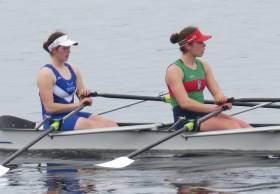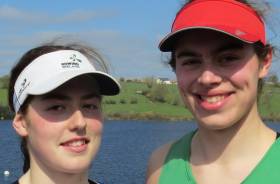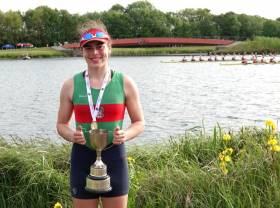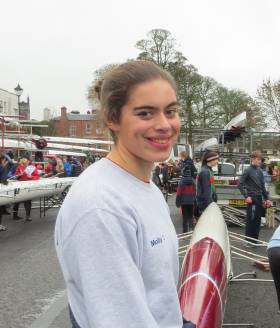Displaying items by tag: Molly Curry
St Joseph's Shine at Head of the Shannon
St Joseph's of Galway were the fastest crew in the shortened second head at the Head of the Shannon rowing event in Carrick on Shannon today. The men's junior 18A eight rowed well and set a provisional time of nine minutes 19.3 seconds.
Commercial's men's junior 18A quadruple were almost as fast, winning their class in nine minutes 22.6 seconds.
The fastest women's crew was the Commercial club one eight, while the Tribesmen/Athlone combination came home fastest of the mixed masters eights.
Brian Colsh of Sligo came home fastest of the junior men's single scullers; Molly Curry was the best women's junior single sculler.
The conditions were surprisingly good, with the water calmer as the afternoon went on.
Fifth for Ireland at World Junior Championships
#Rowing: Ireland’s Molly Curry and Rhiannon O’Donoghue finished fifth in the junior double at the World Rowing Junior Championships in Tokyo. The race was won by the outstanding Lisa Bruijnincx and Jacobien van Westreenen of the Netherlands. The Dutch pushed China into second. Behind them Germany lost out to Lithuania in the battle for bronze.
Curry and O’Donoghue initially fought it out with Greece for fifth. They won this battle and made up metres on Germany, but could not quite push into the battle for medals.
World Rowing Junior Championships, Tokyo, Day Five (Irish interest)
Men
Junior Four, coxed – A Final: 1 Germany 6:32.41, 2 South Africa 6:32.71, 3 China 6:33.90; 4 Ireland (J O’Donovan, M Gallagher, J Dorney, J Kearney; cox: L O’Regan) 6:34.82.
Women
Junior Double Sculls – A Final: 1 Netherlands 7:25.50, 2 China 7:27.66, 3 Lithuania 7:30.23; 5 Ireland (R O’Donoghue, M Curry) 7:38.08
Ireland's Curry and O'Donoghue Qualify for A Final in Tokyo
#Rowing: Ireland’s Rhiannon O’Donoghue and Molly Curry will compete in the A Final of the junior double sculls at the the World Junior Championships in Tokyo on Sunday. The Ireland crew took a clear third place in their semi-final this morning.
The Netherlands were impressive winners, while Lithuania raced well to take second. Ireland pulled clear of Belgium to sit in a qualification spot at 1500 metres. Italy pushed hard coming to the line, but they could not overhaul the Killorglin and Coleraine Grammar School girls.
China were the best crew in the first semi-final and look to the be the key challengers to Lisa Bruijnincx and Jacobien van Westreenen of the Netherlands. Germany were second to China and Greece won a contest with Britain to take third.
World Rowing Junior Championships, Day Four (Irish interest):
Women
Junior Double – Semi-Final Two (First Three to A Final; rest to B Final): 1 Netherlands 7:06.94, 2 Lithuania 7:12.66, 3 Ireland (R O’Donoghue, M Curry) 7:13.46; 4 Italy 7:15.71.
Semi-Final One: 1 China 7:09.41, 2 Germany 7:12.26, 3 Greece 7:14.12.
#Rowing: Ireland’s Molly Curry and Rhiannon O’Donoghue won their repechage and qualified for the A/B semi-finals at the World Junior Championships in Tokyo.
The Ireland junior women’s double overhauled Hungary in an impressive move. With 300 metres to go they were down; they drew level at 1750 and then motored clear to win by just over a length.
Ireland’s junior men’s coxed four had earlier qualified for their A Final by taking second in their heat.
World Rowing Junior Championships, Day Two (Irish interest)
Men
Junior Four, coxed – Heat One (First Two to A Final; rest to Repechage): 1 China 6:18.13, 2 Ireland (J O’Donovan, M Gallagher, J Dorney, J Kearney; cox: L O’Regan) 6:18.29; 3 South Africa 6:18.87.
Women
Junior Double Sculls – Repechage One (First Two to A/B Semi-Finals; rest to C/D Semi-Finals): 1 Ireland (R O’Donoghue, M Curry) 7:10.06, 2 Hungary 7:13.17.
#Rowing: Ireland’s Molly Curry and Rhiannon O’Donoghue finished second in their heat of the junior double sculls at the World Junior Championships in Tokyo this morning.
There was just one direct qualification spot for the A/B Semi-Finals, and the Netherlands were outstanding winners of this race. Lisa Bruijnincx and Jacobien van Westreenen made strong claims for being the best crew in this class with a big win.
Curry and O’Donoghue fought an exciting battle with Italy in the second half and won this by a length and a third. Greece, China and Belgium were the other heat winners.
Because of a worry about adverse weather, racing was run at five minute intervals, which brought forward the time of this heat.
World Rowing Junior Championships, Tokyo, Day One (Irish interest)
Women
Junior Double Sculls – Heat Four (Winner to A/B Semi-Final; rest to Repechages): 1 Netherlands 7:08.18; 2 Ireland (R O’Donoghue, M Curry) 7:16.55, 3 Italy 7:19.59.
#Rowing: Molly Curry won the Girls Championship Singles final at the National Schools Regatta at Dorney Lake today to take the Internationals Cup.
The Coleraine Grammar School rower had over two seconds to spare over Lauren Henry in the A Final. It is a significant win for Curry, who is pre-selected to represent Ireland at the World Junior Championships in Tokyo in August in a double with Rhiannon O'Donoghue of Killorglin.
Curry turns 17 this year and has another year as a junior rower.
O'Driscoll and O'Donovan Trialled in a Four
#Rowing: An Ireland heavyweight four of Mark O’Donovan, Fionnan Crowley, Andy Harrington and Shane O’Driscoll got its first outing in the second session of the Ireland Trials on Saturday. Their test against Ronan Byrne and Philip Doyle – who did have a handicap of 15 seconds – ended with a victory for the double.
The pair of Monika Dukarska and Aifric Keogh got a battle from the junior double of Molly Curry and Rhiannon O’Donoghue, in a race won by lightweight single sculler Fintan McCarthy.
At the London Head of the River, provisional rankings placed Commercial’s senior eight 20th.
Curry is Afloat Rower of the Month for February
#Rowing: The Afloat Rower of the Month for February is Molly Curry. In a set of weeks in which action on the water was severely limited because of windy weather, the Ireland trials at the National Rowing Centre were welcome – and of high quality. World Rowing Champions Paul O’Donovan and Sanita Puspure won in fine style, while the standard of junior rowing was notable. Curry, from Coleraine Grammar School, showed good form. She was the top woman junior in the time trial and went on to compete in the same 2,000 metre race as Puspure.
Rower of the Month awards: The judging panel is made up of Liam Gorman, rowing correspondent of The Irish Times and David O'Brien, Editor of Afloat magazine. Monthly awards for achievements during the year will appear on afloat.ie. Keep a monthly eye on progress and watch our 2019 champions list grow.



























































